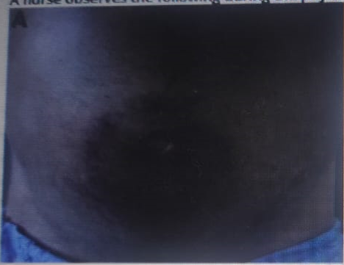A nurse observes the following during the physical exam. How will the nurse document this finding?

Grey-Turner Sign
Steatorrhea
Asterixis
Cullen's Sign
The Correct Answer is D
A. Grey-Turner Sign: Grey-Turner Sign refers to bruising along the flanks, often associated with retroperitoneal hemorrhage or acute pancreatitis.
B. Steatorrhea: Steatorrhea refers to fatty stools that are pale, bulky, and foul-smelling, indicating malabsorption, not a physical exam finding on the skin.
C. Asterixis: Asterixis, also known as "liver flap," is a tremor of the hand when the wrist is extended, seen in hepatic encephalopathy, not a skin finding.
D. Cullen's Sign: Cullen's Sign is bruising around the umbilicus, indicating intra-abdominal bleeding, often seen in conditions such as acute pancreatitis or ruptured ectopic pregnancy.
Nursing Test Bank
Naxlex Comprehensive Predictor Exams
Related Questions
Correct Answer is A
Explanation
A. Performing a 12-lead ECG: An ECG is the most definitive and immediate tool to determine if chest pain is cardiac in origin, as it can detect ischemic changes, arrhythmias, or other cardiac abnormalities.
B. Administering NTG to see if the pain goes away: While nitroglycerin (NTG) may relieve ischemic chest pain, it is not definitive for diagnosing the pain's origin and should not be the first step without further assessment.
C. Gathering a complete medical history: Although a medical history is important, it will not immediately determine if the pain is cardiac in origin.
D. Asking the patient if performing a Valsalva maneuver reduces the pain: The Valsalva maneuver is not a reliable method to differentiate cardiac from non-cardiac chest pain and could potentially worsen certain conditions.
Correct Answer is C
Explanation
A. Ask a family member to interpret what the client is trying to communicate: While family members can sometimes help, the nurse should directly facilitate communication with the client using appropriate tools.
B. Ask the physician to wean the client off the mechanical ventilator to allow the client to talk: Weaning off a ventilator should only be done based on medical stability, not solely for communication purposes.
C. Ask the client to write, use a picture board, or spell words with an alphabet board: These tools can help non-verbal clients on mechanical ventilation express themselves and reduce frustration.
D. Assure the client that everything will be all right and that he shouldn't become upset: This response is dismissive and does not address the client's need to communicate.
Whether you are a student looking to ace your exams or a practicing nurse seeking to enhance your expertise , our nursing education contents will empower you with the confidence and competence to make a difference in the lives of patients and become a respected leader in the healthcare field.
Visit Naxlex, invest in your future and unlock endless possibilities with our unparalleled nursing education contents today
Report Wrong Answer on the Current Question
Do you disagree with the answer? If yes, what is your expected answer? Explain.
Kindly be descriptive with the issue you are facing.
